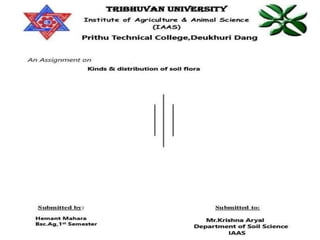
Soil Flora
- 3. 1.Soil Macroflora (Roots of higher plants) The dead plant contribute to the formation of soil organic matter which provides food, energy and nutrients to microorganisms and also higher plants –A process of cycling of plant nutrients Decay of plant roots add O.M. to soil, thereby changing soil properties viz. soil aggregation, CEC, water & nutrient retention capacity, etc. of soil. While proliferating, the roots exert tremendous pressure on surrounding particles. When roots decay, the vacant space makes room for water & air to move it as well as more food to the microbes, influencing thereby microbial activity of soil.
- 5. 2.Microflora Micro flora of soil is an integral part of soil organic matter. Soil bacteria and fungi are the start of the soil food web that supports other organisms. Bacteria constitute the most abundant groups of microorganisms in soil and the fungal population of soils constitutes a very heterogenous group of organisms.
- 9. They are known for rapid proliferation. size varies from 0.5 to 1 micron (diameter) & 1 to 10 micron(length). They have flagella & are motile. They are most abundant in soil. 300 to 3000 kg of live weight of bacteria/ha, 0.01 to 0.4% of total soil mass. Shape may be round (cocci), rod like(bacilli) or spiral (spirilla). In the soil the rod shaped ones seem to predominate. Bacterial population vary from few billion to three trillion in each kilogram of soil.
- 14. Actinomycetes Thread/filamentous. Next to bacteria in abundance Prokaryotic in nature, classified with bacteria Form mycelium and asexual spores like fungi Cell wall composition same as bacteria i.e. peptidoglycan Transitional group between bacteria & fungi Active in degrading more resistant organic compounds
- 17. Fungi A fungus is any member of the group of eukaryotic organisms that includes microorganisms such as yeasts and molds, as well as the more familiar mushrooms. These organisms are classified as a kingdom, which is separate from the other eukaryotic life kingdoms of plants and animals. Fungi (singular: fungus) are a kingdom of usually multicellular eukaryotic organisms that are heterotrophs (cannot make their own food) and have important roles in nutrient cycling in an ecosystem.
- 18. The five true phyla of fungi are the Chytridiomycota (Chytrids), the Zygomycota (conjugated fungi), the Ascomycota (sac fungi), the Basidiomycota (club fungi) and the recently described Phylum Glomeromycota. Fungi reproduce both sexually and asexually, and they also have symbiotic associations with plants and bacteria. Fungi dominants in acid soil Prefer acid medium (4.5 to 6.5). Some fungi can tolerate even pH 9.0
- 24. Algae is a simple, non-flowering, and typically aquatic plant of a large group. It includes the seaweeds and many single-celled forms. Algae are photosynthetic creatures, contain chlorophyll but lack true stems, roots, leaves, and vascular tissue. They are neither plant, animal or fungi. Many algae are single celled, however some species are multicellular. Algae are protists with characteristics that resemble those of plants. They are most commonly found in aquatic environments Algae
- 28. There are seven major types of algae, each with distinct characteristics: Euglenophyta (Euglenoids) are fresh and salt water protists. Some euglenoids are autotrophic while others are heterotrophic. Chrysophyta (Golden-brown algae and Diatoms) are the most abundant types of single-celled algae (approximately 100,000 different species). Pyrrophyta (Fire algae) are single-celled algae. They are found in both the oceans and in fresh water. They use flagella to move around.
- 29. Chlorophyta (Green algae) typically live in freshwater. Green algae have cell walls made of cellulose and are photosynthetic. Rhodophyta (Red algae) are mostly found in tropical marine environments. These eukaryotic cells do not have flagella and centrioles, unlike other types of algae. Paeophyta (Brown algae) are among the largest species. Examples include both seaweed and kelp. Xanthophyta (Yellow-green algae) are the least common species of algae. They are single-celled and both cellulose and silica make up their cell walls.
